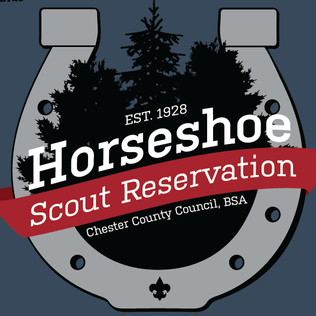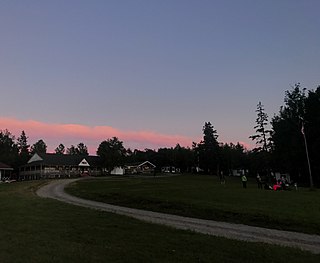
The Order of the Arrow (OA) is the honor society of the Boy Scouts of America (BSA), composed of Scouts and Scouters who best exemplify the Scout Oath and Law in their daily lives as elected by their peers. The society was created by E. Urner Goodman, with the assistance of Carroll A. Edson, in 1915 as a means of reinforcing the Scout Oath and the Scout Law. It uses imagery commonly associated with American Indian cultures for its self-invented ceremonies. These ceremonies are usually for recognition of leadership qualities, camping skills, and other scouting ideals as exemplified by their elected peers.

A summer camp or sleepaway camp is a supervised program for children conducted during the summer months in some countries. Children and adolescents who attend summer camp are known as campers. Summer school is usually a part of the academic curriculum for a student to make up work not accomplished during the academic year.

A camporee is a local or regional gathering of Scouting units for a period of camping and common activities. Similar to a camporee, a jamboree occurs less often and draws units from the entire nation or world. It should not be confused with the Australian term "jamborette".

Firecrafter is a service organization within the Boy Scouts of America. Formed in 1920, the Firecrafter Organization mainly operates within the Crossroads of America Council, Indiana, but has been known to exist in other areas including Illinois and Texas.
Camp Becket, also known as Camp Becket-in-the-Berkshires, is a YMCA summer camp for boys in the Berkshires of western Massachusetts. Founded in 1903 by George Hannum on Rudd Pond in Becket, Massachusetts, it is one of the oldest continually operational summer camps in the United States, and is consistently rated among the best camps of its kind. The camp continues to teach core values espoused by its second director, Henry Gibson.

The Horseshoe Scout Reservation is a Boy Scouts of America camp, owned by the Chester County Council, and located on the Mason-Dixon line separating Pennsylvania and Maryland. The name of the camp derives from the Octoraro Creek, a tributary of the Susquehanna River, that makes a meandering 4-mile horseshoe through the property.
Camp Sizanani was founded as a joint venture between Global Camps Africa, a non-profit headquartered in Reston, Virginia, and HIVSA, a South African foundation that provides care and services to HIV-affected individuals. Operating in the Magaliesburg area in North West Province, South Africa, Camp Sizanani offers multiple camp sessions throughout the year for children aged twelve through nineteen whose lives have been affected by HIV/AIDS. The term HIV-affected can imply that an individual is infected with the virus, but it can also mean that the infection of family members or guardians have impacted the individual's life. While some children at Camp Sizanani are HIV+, many more have been orphaned by a parent's AIDS-related death or have family members coping with the disease. Nearly all of Sizanani's campers come from Soweto, Johannesburg's enormous township, to which many black Africans were relegated during South Africa's apartheid era. The children attend the camp free of charge; they are sponsored by Global Camps Africa and its donors.
Frost Valley YMCA is a camping, environmental education, and conferencing center located in Claryville, New York, part of the Catskill Mountains. Founded in 1901 as Camp Wawayanda, the camp moved to its present location in 1958.
Camp Ramah in Wisconsin is a Jewish summer camp based in Conover, Wisconsin, on Upper Lake Buckatabon. The Wisconsin camp was the first of the Ramah camps, established in 1947 by Rabbi Ralph Simon, under the direction of Conservative educator Henry Goldberg, with nearly 100 campers. It was sponsored by the Chicago Council of Conservative Synagogues and the Midwest Branch of the United Synagogue.
Camp Sealth is owned and operated by Camp Fire, a non-profit youth organization, and located on Vashon Island, Washington. Sealth hosts resident and day camp during the summer, environmental education for school groups during the spring and fall, and is a year-round conference and retreat center. Camp Sealth is accredited by the American Camp Association.

The Mayflower Council of the Boy Scouts of America serves the MetroWest and southeastern regions of Massachusetts.

Big Cove YMCA Camp or Big Cove, is a residential camp for children aged 6–16 located in Sutherlands River, Nova Scotia. The camp is the oldest residential camp in Canada, founded by what is now called the YMCA of Greater Halifax/Dartmouth in 1889. It is located on a 100-acre peninsula on Merigomish Harbour in Pictou County.

YMCA Camp Fitch is a year-round camp in North Springfield, Pennsylvania, owned and operated by the YMCA of Youngstown, Ohio. Prior to 1914, all summer camps operated by the YMCA of Youngstown were experimental and temporary in nature. Since its founding in 1914, Camp Fitch has hosted campers every year to date. Originally a program of the YMCA's downtown branch, Camp Fitch now exists as a YMCA branch owned by the YMCA of Youngstown.

Samoset Council is a Boy Scout council headquartered in Weston, Wisconsin that serves north central Wisconsin. Founded in 1920, the council gets its name from an early Boy Scout camp in the Town of Harrison named Camp Sam-O-Set. The council is served by Tom Kita Chara Lodge of the Order of the Arrow.
YMCA Camp Tecumseh Outdoor Center is located in Indiana near the towns of Brookston, Indiana and Delphi, Indiana on the Tippecanoe River. The closest large city to Camp Tecumseh is Lafayette, Indiana, which is just across the Wabash River from West Lafayette. Camp Tecumseh was established in 1924 when citizens of Delphi raised $3000 to purchase the land which lies on a bend on the Tippecanoe river. The camp is named after Tecumseh, a Shawnee chief. Camp Tecumseh is fully accredited by the American Camping Association and currently serves over 4,000 campers every summer from throughout the midwest USA and the world. Camp Tecumseh is also open throughout the year, providing an Outdoor Education service for schools and a facility for retreats and conferences of all kinds. The facility serves over 30,000 people per year. It is an independent YMCA branch and is operated independently of other metro YMCAs.
The Cleveland Sight Center (CSC) is a non-profit organization that provides services to individuals who are blind or visually impaired. Founded in 1906, it is accredited by the Commission on Accreditation of Rehabilitation Facilities (CARF) and serves around 10,000 clients annually in Northeast Ohio. The organization also has radio-reading and community outreach programs that benefit a larger number of individuals.
Camp Anokijig is a residential youth summer camp located in Plymouth, Wisconsin on Little Elkhart Lake. Founded in 1926 by the Racine YMCA, Camp Anokijig is now independently owned and operated by the non-profit group Friends of Camp Anokijig, and operates year-round. Camp Anokijig is accredited by the American Camping Association.

YMCA Camp Mason is a YMCA summer camp located in Hardwick Township, New Jersey. The 650-acre site is located next to the Delaware Water Gap National Recreation Area. Camp Mason annually serves approximately 800 campers in its summer camp programs, and 7,000 participants at its outdoor center.

Camp Ondessonk is a rustic, outdoor, Catholic youth camp run by the Belleville Diocese. It is located in the Shawnee National Forest of Southern Illinois, near Ozark, Illinois. The camp strives to remain a “last frontier” of sorts, where participants can experience life away from the plugged in world of today's society, and go back to a time of outdoor living while experiencing nature to the fullest. Camp Ondessonk states their mission to be "to provide an environment that inspires physical, mental, emotional, and spiritual growth for individuals and groups through the appreciation and stewardship of nature." Camp Ondessonk is accredited by the American Camp Association.
Camp Jones Gulch is a YMCA summer camp in La Honda, California, in the Santa Cruz Mountains of the San Francisco Bay Area. It was founded in 1934 and encompasses 927 acres (375 ha) of redwood forests and meadows. During the summer, the YMCA of San Francisco operates overnight youth and family camps, and during the school year, the camp hosts retreats, in addition to weekly environmental education field trips operating as San Mateo Outdoor Education. From 1956 to 2020, it was also the home of San Joaquin County Outdoor Education.











